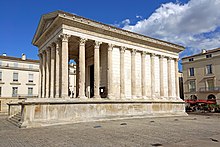
Back عمارة رومانية Arabic العماره الرومانيه ARZ Arquiteutura de l'Antigua Roma AST Qədim Roma memarlığı Azerbaijani Римска архитектура Bulgarian Rimska arhitektura BS Arquitectura romana antiga Catalan Architektura starověkého Říma Czech Romersk arkitektur Danish Römische Architektur German
 The Colosseum in Rome (c. 70–80) | |
| Years active | 509 BC (establishment of the Roman Republic) – 4th century AD |
|---|---|
Ancient Roman architecture adopted the external language of classical ancient Greek architecture for the purposes of the ancient Romans, but was different from Greek buildings, becoming a new architectural style. The two styles are often considered one body of classical architecture. Roman architecture flourished in the Roman Republic and to an even greater extent under the Empire, when the great majority of surviving buildings were constructed. It used new materials, particularly Roman concrete, and newer technologies such as the arch and the dome to make buildings that were typically strong and well engineered. Large numbers remain in some form across the former empire, sometimes complete and still in use today.
Roman architecture covers the period from the establishment of the Roman Republic in 509 BC to about the 4th century AD, after which it becomes reclassified as Late Antique or Byzantine architecture. Few substantial examples survive from before about 100 BC, and most of the major survivals are from the later empire, after about 100 AD. Roman architectural style continued to influence building in the former empire for many centuries, and the style used in Western Europe beginning about 1000 is called Romanesque architecture to reflect this dependence on basic Roman forms.

The Romans only began to achieve significant originality in architecture around the beginning of the Imperial period, after they had combined aspects of their originally Etruscan architecture with others taken from Greece, including most elements of the style we now call classical architecture. They moved from trabeated construction mostly based on columns and lintels to one based on massive walls, punctuated by arches, and later domes, both of which greatly developed under the Romans. The classical orders now became largely decorative rather than structural, except in colonnades. Stylistic developments included the Tuscan and Composite orders; the first being a shortened, simplified variant on the Doric order and the Composite being a tall order with the floral decoration of the Corinthian and the scrolls of the Ionic. The period from roughly 40 BC to about 230 AD saw most of the greatest achievements, before the Crisis of the Third Century and later troubles reduced the wealth and organizing power of the central governments.
The Romans produced massive public buildings and works of civil engineering, and were responsible for significant developments in housing and public hygiene, for example their public and private baths and latrines, under-floor heating in the form of the hypocaust, mica glazing (examples in Ostia Antica), and piped hot and cold water (examples in Pompeii and Ostia).